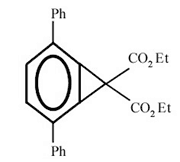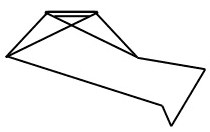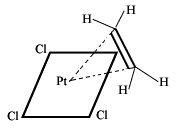by, Sithamalli K. Balasubramanian - Ph.D.
 Fig.
14
Fig.
14
 Fig. 15
Fig. 15
 Fig. 16a
Fig. 16a
 Fig, 16b
Fig, 16b
A more surprising prediction by our model is that the tetrahedral apex positions, being b-surfaces, should also be available for bond formation to a methylene group to produce the bicyclo - (1,1,0) – but - 1(3)-ene (16a). This system had been identified as a transient intermediate (16b) {ref.23}.
These two systems (15 & 16) provide strong evidence that the olefin group in cyclopropene is indeed the b-b, q-q type.
The Zeisse’s Salt: This salt (17), K + [ Pt Cl3 C2H4 ] - poses severe difficulties to the quantum theory {ref.24,25}. The properties of the salt are as follows: The structure is established by the x-ray method. Platinum is at the centre of a square with Chlorine atoms at three corners and a nearly vertical ethylene at the fourth corner. The C=C bond length is 137pm.
The olefinic bond is shown by Raman spectrum (1243 cm-1) and is a weak bond. The olefinic carbon atoms are tetrahedral. They are swung away from the metal and are oriented unsymmetrically with respect to the Platinum-Carbon plane. The olefin platinum bond is rigid because in the n.m.r spectrum the Pt195 - H coupling is invariant with temperature. On the other hand the olefinic hydrogens appear as a broad hump at ordinary temperature which gets resolved into two sharp peaks at low temperature, showing that these hydrogens change their relative positions at room temperatures within the nmr time framework and get fixed in low temperatures in a single structure or two identical structures.
To explain the temperature dependence of the nmr spectrum it was assumed that the ethylene molecule would rotate around the axis represented by the diagonal through Platinum and the centre of the olefin bond. ...top
Such rotation would violate the observation of the invariant coupling of Pt195 -H. The Pt-C bond is known to be rigid and there is no way the rotation could be accommodated.
It was necessary to postulate a new type of bond, clever but clumsy, called the “σ - donation - π - back donation bond” {ref.25} as the carbon atoms would not have enough electrons to form bond with Platinum and still retain their olefinic character. The olefinic carbons are obviously pentavalent which is not permitted by the quantum model in which the two 1s2 electrons are locked up in the so-called inner shell and hence are not available for bond formation.
The conflict inherent in the situation had been known to the philosophers as one between empiricism as represented by experimental science and rationalism as represented by mathematics.
Our model provides a simple explanation of the properties of the Zeisse’s salt (17). The olefinic bond is the b-b, q-q type which is weaker than the van’t Hoff double bond. The carbon atoms are tetrahedral with the hydrogens at the base and the metal at the apex. The hydrogens would point away from the metal and would be unsymmetrically distributed with respect to the Platinum Carbon plane. The metal olefin bond would be rigid and would not permit any free rotation about the Pt-olefin axis. The double bond is flexible and thermal agitation would make the carbons swing from one set of q-surfaces (17a) to another (17c) through a symmetrical intermediate (17b) in which the carbons are quadrivalent. The transition from the pentavalent state to the quadrivalent state provides the driving force to the swing which accounts for the temperature variance of the nmr spectrum. It had been pointed out earlier that the b-b, q-q double bond is of higher energy than the van’t Hoff double bond. The inherent instability arising therefrom and the overcrowded bonding inherent in the pentavalent carbon account for the ready replacement of one olefin in the complex by another by a simple mass effect. The model thus accounts for all the properties of Zeisse’s salt within one framework.
The olefinic carbons in Zeisse’s salt are nominally pentavalent. The existence of the salt as a stable crystalline compound constitutes a strong argument against the presence of an inaccessible shell of 1s2 electrons in carbon. If the carbon is pentavalent the molecule should have a free electron on each carbon and the molecule should be paramagnetic. Since the molecule does not show paramagnetism there is no ‘free’ electron. Earlier we had said that q-surfaces are nominal null areas in an atom. As such we do not want to enter into a detailed discussion of the origin of bonding electrons.
 Fig. 17 - Zeisse's salt.
Fig. 17 - Zeisse's salt.

Fig. 17a, 17b, 17c,
The swing of the tetrahedral double bond.